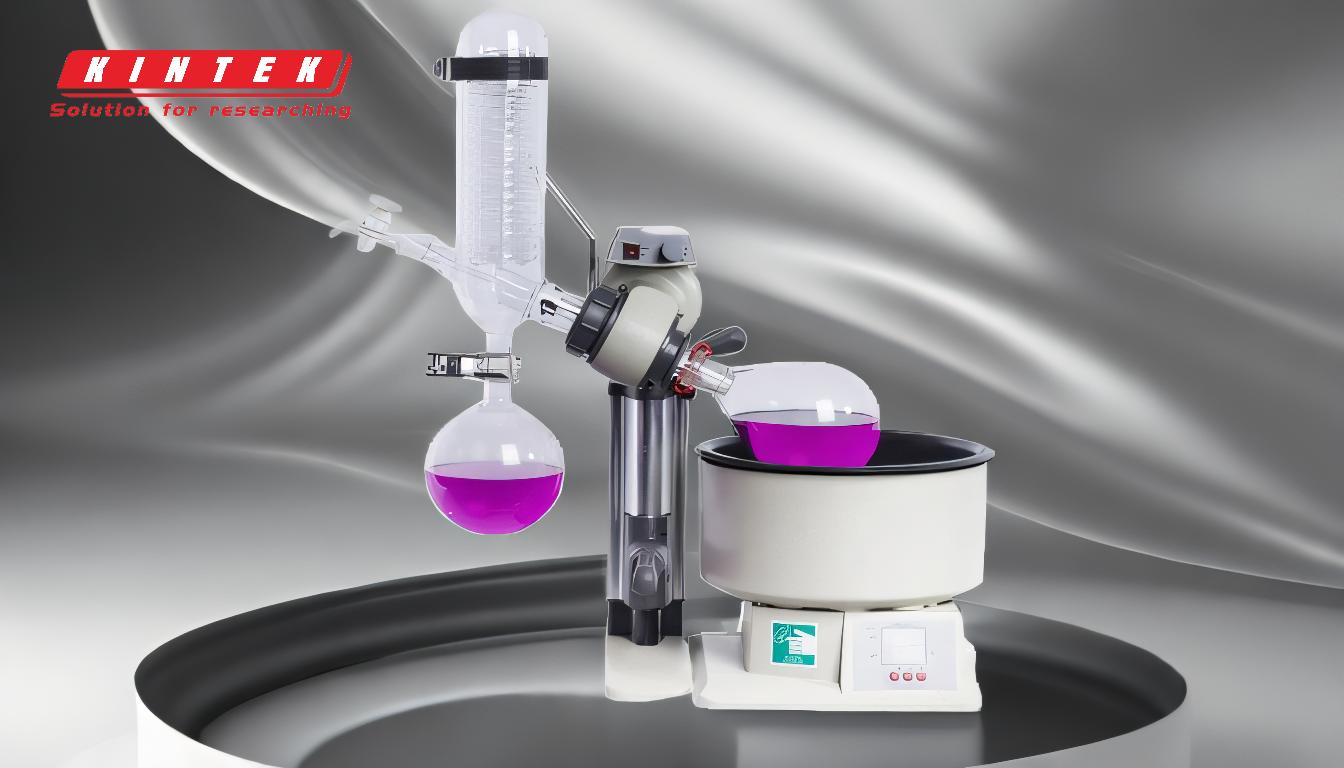The rotary evaporator, or rotavap, is a laboratory device used to efficiently and gently remove solvents from samples through evaporation. It operates under reduced pressure, which lowers the boiling point of solvents, allowing them to evaporate at lower temperatures and preserving the integrity of heat-sensitive compounds. The process involves rotating a flask containing the sample in a heated water bath, creating a thin film that increases the surface area for evaporation. The solvent vapors are then condensed and collected in a separate flask, while the vacuum system maintains the reduced pressure. This method is widely used in chemistry, pharmaceuticals, and food science for solvent recovery, concentration, and purification.
Key Points Explained:

-
Preparation and Setup:
- Turn on the water bath: Set the water bath to the desired temperature, ensuring it is appropriate for the solvent being evaporated.
- Ensure water flow to the condenser: Confirm that water is flowing into the condenser to facilitate cooling and condensation of the solvent vapors.
- Attach the flask: Connect the round-bottom flask containing the sample to the rotary evaporator, securing it with a clip to prevent detachment during rotation.
-
Creating a Vacuum:
- Turn on the vacuum pump: Activate the vacuum pump to reduce the pressure within the system. This lowers the boiling point of the solvent, enabling evaporation at lower temperatures.
- Close the vacuum tap: Immediately after turning on the vacuum pump, close the tap to maintain the reduced pressure environment.
-
Rotation and Evaporation:
- Start the rotation: Turn on the motor to rotate the flask at a controlled speed. This rotation creates a thin film of the sample on the inner walls of the flask, increasing the surface area for evaporation.
- Monitor for bumping: Briefly observe the flask to ensure that the sample does not "bump" or splash, which can occur if the pressure is too low or the rotation speed is too high.
- Lower the flask into the water bath: Gradually lower the rotating flask into the heated water bath to promote even heating and efficient evaporation.
-
Condensation and Collection:
- Condense the solvent vapors: As the solvent evaporates, the vapors travel through the vapor duct and are cooled by the condenser, turning them back into a liquid.
- Collect the condensed solvent: The liquid solvent is collected in a separate receiving flask, while the non-volatile components remain in the original flask.
-
Completion and Shutdown:
- Raise the flask: Once the solvent has been removed, raise the flask out of the water bath to stop further heating.
- Stop the rotation: Turn off the motor to halt the rotation of the flask.
- Release the vacuum: Carefully open the vacuum tap to release the reduced pressure and return the system to atmospheric pressure.
- Turn off the vacuum pump: Deactivate the vacuum pump to complete the process.
- Remove the flask: Detach the flask from the rotary evaporator, ensuring it is handled carefully to avoid spills or contamination.
-
Key Principles and Benefits:
- Reduced pressure: The vacuum system lowers the boiling point of the solvent, allowing for gentle evaporation at lower temperatures, which is crucial for heat-sensitive compounds.
- Increased surface area: The rotation of the flask creates a thin film, maximizing the surface area for evaporation and speeding up the process.
- Efficient solvent recovery: The condensed solvent is collected separately, enabling easy recovery and reuse, which is both cost-effective and environmentally friendly.
By following these steps, the rotary evaporator provides a controlled and efficient method for solvent removal, making it an indispensable tool in various scientific and industrial applications.
Summary Table:
| Step | Description |
|---|---|
| Preparation | Set water bath temperature, ensure water flow to condenser, attach sample flask. |
| Creating a Vacuum | Turn on vacuum pump, close vacuum tap to maintain reduced pressure. |
| Rotation & Evaporation | Rotate flask to create thin film, monitor for bumping, lower into water bath. |
| Condensation | Condense solvent vapors, collect in receiving flask. |
| Completion | Raise flask, stop rotation, release vacuum, turn off pump, and remove flask. |
| Key Benefits | Gentle evaporation, increased surface area, efficient solvent recovery. |
Discover how a rotary evaporator can optimize your lab processes—contact us today!













